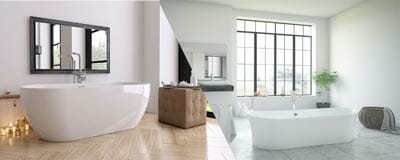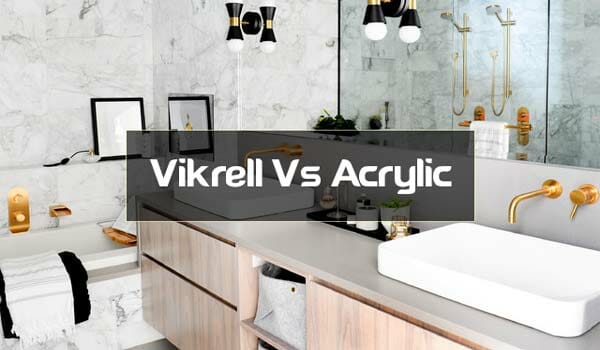SeaRanchLodge.com is a participant in the Amazon Associate program and will earn from qualifying purchases.
Be it executives sitting on a top floor chamber, new mothers struggling to manage their kids, or students sweating over their current project – all have one thing in common. They definitely dream about taking a long relaxing bath in the comfort of a well-made tub after completing their tasks.
In order to enjoy such a refreshing experience, you first have to make sure that you are investing in the right kind of bathtub. That is why we are here to find out which material will suit your shower experience better by comparing Vikrell vs. Acrylic – two of the most popular options available right now.
What is Vikrell?
Vikrell is actually the brand name for a particular material used to build bathtubs and other bathroom fittings. This material is made with a combination of fiberglass and polyresin.
The fiberglass itself consists of plastic and fine glass fibers. So when polyresin is added to it, the resulting substance becomes even more robust. That is why using it as the base of shower fixtures is so popular.
Advantages of Vikrell
Durable
As we mentioned, Vikrell provides a strong base for bathtubs due to its combined power of fiberglass and polyresin. Because of its robustness, it tends to last a long time. It can fight against wear and tear like a valiant warrior without giving up too soon. Usually, these pieces last at least a decade while used residentially.
Moldable
Vikrell is pretty easy to mold into whatever shape you want. So if you want a special design or require specific customizations on your bathroom fittings, it will be easily possible with this material. That is why the people who are very particular about their shower decor prefer Vikrell bathtubs over others.
Lightweight
Even though Vikrell is pretty strong and durable, it doesn’t weigh too much. This lightweight structure makes it easier for fixture professionals to carry the structure. So if you have been looking for materials that score high in terms of portability, Vikrell should definitely be on your list.
Watertight
Each piece of Vikrell forming the complete structure is naturally capable of maintaining a strong bond with other pieces. As a result, they end up creating a watertight seal by themselves. So you can skip the step of caulking the seams in these showers. The tight fit of interlocking sections takes care of it regardless.
Long-Lasting Color
Many of us spend a lot of time deciding on the best colors for our bathroom interior. It would be a shame to lose all that progress over time due to a poor choice of material.
Vikrell ensures that you don’t have to regret the thoughtful designs and color combinations since it can retain its original hue longer than most.
Easy To Clean
Another great advantage Vikrell offers to people who take their bathroom appearance seriously is its superior stain resistance. This material can keep stains away even if it has been exposed to a wide variety of dirt particles. You can clean up most of them with just one wipe or a bit of cleaning solution.
Disadvantages of Vikrell
Challenging Installation
The major disadvantage of using a Vikrell bathtub or shower fixtures is how much time, attention, and expertise it takes to install them properly. This procedure requires extensive knowledge regarding the foundation, support, and other crucial aspects of installing such structures made for the bathroom.
For instance, it is important to establish a mortar bed before installing the bathtub over it. This needs to be done even if the manufacturer does not mention it. The foundation will keep the tub from getting warped or broken over time by providing it the required support.
Monotonous Appearance
Vikrell is only available in white color, which may be a major disadvantage for anyone who has been planning for a vibrant bathroom. Besides, most shower spaces in the world come with the default color of white anyway. So it may not seem like the best idea for all the creative individuals looking for the perfect fit.
What is Acrylic?
Acrylic is widely known as a form of painting color or a particular fabric. However, it also has a contribution to the industry of shower fixtures!
Many bathtubs are made with acrylic sheets that are made using vacuum, resin, fillers, and fiberglass. They are popular among individuals who appreciate a colorful interior for their bathroom.
Advantages of Acrylic
Non-porous
Similar to Vikrell, the acrylic tubs have also proved to be quite durable. Usually, the material of fiberglass itself is not enough to make the tub last long. It easily soaks in water and leads to the deformation of the tub. Adding acrylic to the mix fixes the pores present in it and stops the water from getting inside.
For all these reasons, it doesn’t suffer from mildew and similar undesired growth on the surface. This extends its lifespan even further.
Lightweight
Fiberglass itself is very lightweight in nature. Even when combined with acrylic, the resulting weight stays on the same level. As a result, it becomes easier to move the tub for the professionals. Besides, these tubs don’t put too much stress on the bathroom floor and keep the space safer for everyone.
Heat Retention
These bathtubs are good at retaining heat since their surface does not contain too many pores. At average room temperatures, it will seem warm to the touch. When you fill it up with hot water for a relaxing shower after a long day, the tub will keep the water warm for an extended period.
Versatile Designs
Compared to other materials, acrylic bathtubs are blessed with a broader palette of beautiful colors. Because of their flexible nature, you can also mold them in an impressive range of shapes. Utilizing these two features simultaneously, you can come up with creative and versatile designs for your shower space!
Disadvantages of Acrylic
Easily Scratched
Even though acrylic bathtubs are very glossy, they are also vulnerable to getting scratched quite easily. Since this material is considerably softer than most, using abrasive cleaners on it ends in some prominent scratches. In order to avoid this situation, you will need to only invest in softer cleaning solutions.
Slightly Expensive
Compared to fiberglass and similar materials, acrylic bathtubs come at a little higher price point. While this may not bring drastic changes to your shower shopping budget, it can push the limits a little further. So if you are dealing with a tough financial situation, acrylic is not the ideal bathtub material.
Comparing Acrylic Vs. Vikrell

Uses
Both Vikrell and acrylic are popular materials for bathtubs and other shower fixtures. Because of their lightweight structure, both are good options for moving into a new home or for bathrooms that can’t handle too much stress. That is why they are equally popular choices for residential and commercial shower spaces.
Composition
While both materials contain fiberglass, they still differ in their physical and chemical characteristics. That is because their composition includes different substances. Vikrell has resin-based plastic in its composition, while acrylic contains plastic molded using the vacuum.
Besides, the proportion of fiberglass also differs among them. Vikrell has a lot of fiberglass elements, while acrylic has a little.
Durability
Acrylic is slightly stronger than Vikrell since it has more of a solid structure. That is why it tends to tolerate physical distress better and survive for a longer time. Vikrell is more susceptible to wear and tear among the two. As a result, acrylic would offer you higher durability than Vikrell.
Repairing Difficulty
If the bathtub suffers from any damage or mishap, it will be easier for you to repair the Vikrell one. The degree of fiberglass in its composition is quite heavy, which means the broken pieces don’t go far from the tub. Its cracks and damages can be fixed quite easily using the correct kind of epoxy resin.
In contrast, disfigured areas on the acrylic bathtub take more time and effort. Its fiberglass ratio is pretty minimal, which makes the repairing job much harder. In most cases, it cannot be fixed.
Cleaning Conveniences
When it comes to the conveniences of cleaning routines, Vikrell scores better than acrylic bathtubs.
Vikrell is made to be resistant to dirty buildups and harmful chemicals. The smoothness of its surface and the resilience of its inherent composition make the cleaning job easier. You can get rid of any dirt with just a wipe.
Although acrylic is not a rough material, its texture is not as uniform as Vikrell. So it tends to pick up more dirt and makes it slightly more difficult to clean.
Versatility
If you are someone who loves playing with colors and want to implement unique creative ideas for their shower space, acrylic bathtubs will be the better option. They come in a wider variety of colors which will give you a wider palette to play with. On the other hand, Vikrell usually comes in only white.
Apart from color restrictions, these two materials offer similar conveniences in terms of design. Because of their flexibility, you can mold them both in any shape you want.
Appearance
For those of you who have sufficient lighting in the bathroom, using either of them will enhance the area even more. They both are glossy materials that reflect light well and bring in a captivating aesthetic in the shower wall and area.
However, the acrylic bathtubs are slightly shinier than the Vikrell ones. In contrast, Vikrell will suit you better if a smooth and uniform surface in one color is all you want for your shower.
Moreover, acrylic surfaces are more prone to discoloration when coming in contact with chemicals of showering essentials. Their color can fade away after reacting with remnants of shampoo, soap, and similar products. Since Vikrell is chemically more inert, its shade stays the same throughout.
Cost-Effective
Acrylic and Vikrell come at very similar price points. So you don’t have to worry too much about choosing the one within your budget. Comparatively, Vikrell is available at a more affordable cost. However, acrylic bathtubs tend to last longer, and thus their slightly higher price point seems to be the more cost-effective one.
Bottom Line – Which One is For You?
It is very tough to decide between two such materials which share almost an equal number of advantages and disadvantages. The true winner in this Vikrell vs. Acrylic competition can only be decided based on what your exact preferences are.
Go for Vikrell if you can’t dedicate too much time to cleaning the tub and want the assurance of easy repair. On the other hand, acrylic bathtubs tend to be more durable, cost-effective, and versatile in appearance. So pick the one which suits your requirements the best.
Our more resources:
- Best crawfish cooker and boilers review and buying guide.
- Choose the best brownie pans from our lists.
- Our list of good cast iron griddle – top 8 picks.
- Our selected rice cereal bottles – An expert reviewed.
- Top 10 beeswax candle lists with buying guide.
About the Author
Tamara J. Sims
EXECUTE CHEF
As a seasoned kitchen and food writer, Tamara has a remarkable ability to weave words together, transporting readers to the heart of the culinary world. Tamara’s articles are written with an engaging blend of insightful commentary, honesty, and real-world examples based on personal experiences. She has the ability to captivate seasoned food enthusiasts and novice cooks alike.


